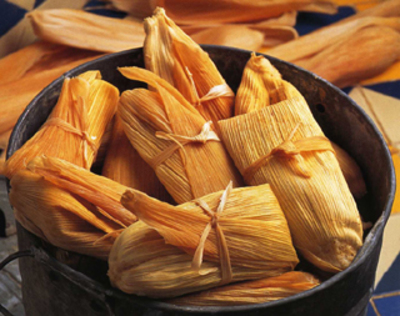“We dress “Niños Dios”
By MoKa Hammeken (republished from 2012)
 At this time of the year, this is a very popular sign that can be seen particularly in small villages and towns across Mexico. The signs are hung on telephone poles or doors of homes in preparation for February 2nd festivities, the Día de la Candelaria (Candlemas day). Within the Catholic church, the “Niños Dios” (which is almost always ceramic) is a representation of the Christ child, and the same form of the figure placed in nativity scenes at Christmas time. In many families this same figure is the one placed in their nativity scene and carries with it many years of tradition and, in some cases, has been passed down from generation to generation. I have seen the figure of “Niño Dios” in many sizes, and wearing all types of clothing from very elaborate fine clothes to soccer jerseys such as that of América (a well-known team from Mexico City) or other teams. Thus, the popular sign to “dress Niño Dios”; dressing Niño Dios is an artform with clothing made to fit the desires and possibilities of the family. Families take the Niño Dios to present him at the temple, and that is why he must be dressed well.
At this time of the year, this is a very popular sign that can be seen particularly in small villages and towns across Mexico. The signs are hung on telephone poles or doors of homes in preparation for February 2nd festivities, the Día de la Candelaria (Candlemas day). Within the Catholic church, the “Niños Dios” (which is almost always ceramic) is a representation of the Christ child, and the same form of the figure placed in nativity scenes at Christmas time. In many families this same figure is the one placed in their nativity scene and carries with it many years of tradition and, in some cases, has been passed down from generation to generation. I have seen the figure of “Niño Dios” in many sizes, and wearing all types of clothing from very elaborate fine clothes to soccer jerseys such as that of América (a well-known team from Mexico City) or other teams. Thus, the popular sign to “dress Niño Dios”; dressing Niño Dios is an artform with clothing made to fit the desires and possibilities of the family. Families take the Niño Dios to present him at the temple, and that is why he must be dressed well.
The Día de la Candelaria is a Catholic celebration based on the biblical passage of when the Christ child was presented at the Temple of Jerusalem by his mother, Mary, thereby fulfilling the Jewish law of presenting the child for purification forty days after being born. The name, Candelaria, (according to tradition) comes from the idea of Christ as the “light of the world”, who has come to illuminate the road as a candle (or candles).
 Catholic traditions go hand in hand with daily life in Mexico. In many places across the country these traditions remain quite strong. Remember our story about Kings’ Day (Jan. 6)? Well, the Día de la Candelaria is intrinsically tied to that celebration. When, on Jan. 6th, we cut the famous Rosca de Reyes (sweet yeast bread shaped in the form of a circle) there was a commitment attached: whoever cut a piece with the small plastic figurine inside now has to bring the tamales and/or champurrado (hot drink made with maiz and chocolate) for celebrations on Feb. 2.
Catholic traditions go hand in hand with daily life in Mexico. In many places across the country these traditions remain quite strong. Remember our story about Kings’ Day (Jan. 6)? Well, the Día de la Candelaria is intrinsically tied to that celebration. When, on Jan. 6th, we cut the famous Rosca de Reyes (sweet yeast bread shaped in the form of a circle) there was a commitment attached: whoever cut a piece with the small plastic figurine inside now has to bring the tamales and/or champurrado (hot drink made with maiz and chocolate) for celebrations on Feb. 2.
So, in this sense of comraderie and complicity, on the Día de la Candelaria people gather in homes – or take a break from work – in order to get together, eat tamales, and drink atole or champurrado while talking just about anything and then continue on with daily life.
MKH
